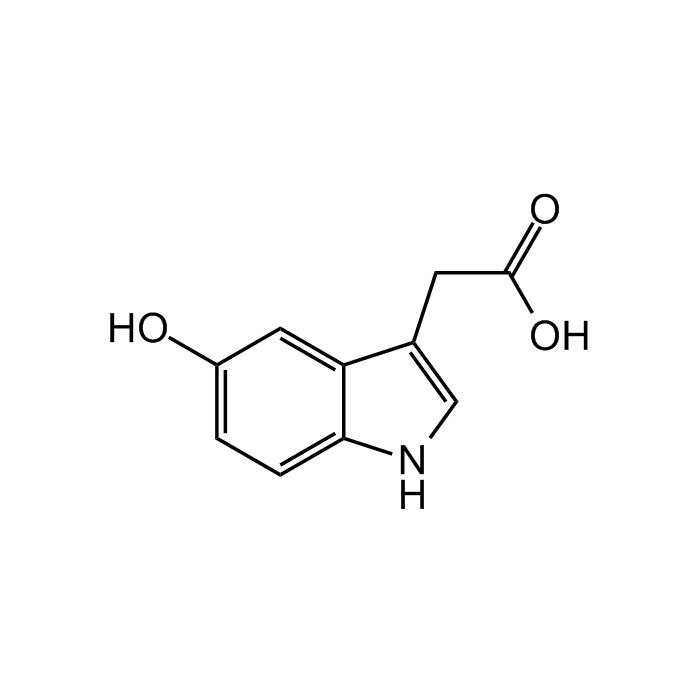Cookie Policy: This site uses cookies to improve your experience. You can find out more about our use of cookies in our Privacy Policy. By continuing to browse this site you agree to our use of cookies.
AdipoGen Life Sciences
5-Hydroxyindole-3-acetic acid
As low as
45
CHF
CHF 45.00
In stock
Only %1 left
AG-CR1-3544-M100100 mgCHF 45.00

| Product Details | |
|---|---|
| Synonyms | 5-HIAA; 5-Oxyindoleacetic Acid; NSC 90432 |
| Product Type | Chemical |
| Properties | |
| Formula |
C10H9NO3 |
| MW | 191.2 |
| CAS | 54-16-0 |
| RTECS | NL3650000 |
| Purity Chemicals | ≥98% |
| Appearance | Off-white solid to beige/purple solid. |
| Solubility | Soluble in DMSO (25mg/ml) or ethanol (25mg/ml). |
| InChi Key | DUUGKQCEGZLZNO-UHFFFAOYSA-N |
| Smiles | OC1=CC=C(NC=C2CC(O)=O)C2=C1 |
| Shipping and Handling | |
| Shipping | AMBIENT |
| Short Term Storage | +4°C |
| Long Term Storage | -20°C |
| Handling Advice | Keep cool and dry. |
| Use/Stability | Stable for at least 2 years after receipt when stored at -20°C. |
| Documents | |
| MSDS |
 Download PDF Download PDF |
| Product Specification Sheet | |
| Datasheet |
 Download PDF Download PDF |
Description
- 5-hydroxy Indole-3-acetic acid (5-HIAA) is the primary metabolite of serotonin, metabolized by monoamine oxidase and aldehyde dehydrogenase in the liver. As the catabolic end product of the serotonin pathway, 5-HIAA is present in body fluids like cerebrospinal fluid (CSF), blood and urine. It can be used as an internal standard for the quantification of serotonin metabolism.
- 5-HIAA is a potent GPR35 receptor ligand, an inflammatory mediator for immune and non-immune cell populations.
- 5-HIAA is secreted by platelets and mast cells during inflammation and by binding to neutrophils has a chemoattractant role. 5-HIAA deficient mice show a loss of GPR35-mediated neutrophil recruitment to inflamed tissue. The chemoattractant GPR35-5-HIAA receptor-ligand system cooperates with other inflammation-induced factors in mediating neutrophil recruitment to sites of inflammation.
- 5-HIAA is excreted in urine and has been used as a biomarker for the detection of neuroendocrine tumors, Celiac disease and Whipple disease, where serotonin expression levels are increased. It also has been associated with metabolic syndrome and low-grade inflammation. 5-HIAA levels are low in CSF in patients with bipolar 1 disorder with childhood attention-deficit hyperactivity disorder (ADHD) or sepiapterin reductase deficiency. 5-HIAA has also been associated with autism, insomnia and chronic migraine and is used as a marker for alcohol abuse.
Product References
- Studies on a simplified method for urine 5-hydroxyindole-acetic acid (5-HIAA): C.R. Ratliff; Am. J. Med. Technol. 28, 83 (1962)
- CSF serotonin metabolite (5-HIAA) studies in depression, impulsivity, and violence: G.L. Brown & M.I. Linnoila; J. Clin. Psych. 51, 42 (1990) (Review)
- Association of biogenic amine metabolites with symptomatology in delusional (psychotic) and nondelusional depressed patients: L. Lykouras, et al.; Prog. Neuropsychopharmacol. Biol. Psych. 19, 877 (1995)
- Comparison of self-reported alcohol intake with the urinary excretion of 5-hydroxytryptophol:5-hydroxyindole-3-acetic acid, a biomarker of recent alcohol intake: A. Kroke, et al.; Br. J. Nutr. 85, 621 (2001)
- Platelet serotonin levels in pervasive developmental disorders and mental retardation: Diagnostic group differences, within-group distribution, and behavioral correlates: E.J. Mulder, et al.; J. Am. Acad. Child Adolesc. Psychiatry 43, 491 (2004)
- Development and validation of an ultra-high performance liquid chromatography-tandem mass-spectrometry (UHPLC-MS/MS) method for the simultaneous determination of neurotransmitters in rat brain samples: R.R. Gonzalez, et al.; J. Neurosci. Meth. 198, 187 (2011)
- High plasma 5-hydroxyindole-3-acetic acid concentrations in subjects with metabolic syndrome:M. Fukui, et al.; Diabetes Care 35, 163 (2012)
- Association of peripheral 5-hydroxyindole-3-acetic acid, a serotonin derivative, with metabolic syndrome and low-grade inflammation: M. Afarideh, et al.; Endocr. Pract. 21, 711 (2015)
- Urinary sampling for 5HIAA and metanephrines determination: revisiting the recommendations: J.-B. Corcuff, et al.; Endocr. Connect. 6, R87 (2017)
- Genetic and biochemical changes of the serotonergic system in migraine pathobiology: C.F. Gasparini, et al.; J. Headache Pain 18, 20 (2017)
- 5-HIAA as a Potential Biological Marker for Neurological and Psychiatric Disorders: H. Jayamohananan, et al.; Adv. Pharm. Bull. 9, 374 (2019)
- GPR35 promotes neutrophil recruitment in response to serotonin metabolite 5-HIAA: M. De Giovanni, et al.; Cell 185, 815 (2022)





